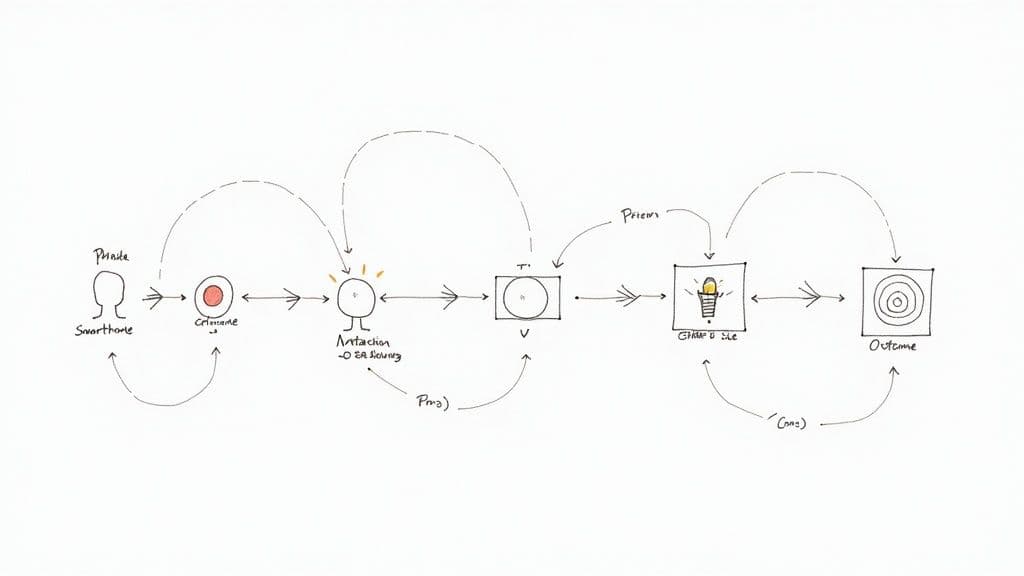Understanding your customer's experience, from their first interaction to long-term loyalty, is crucial for growth. A well-structured user journey template is more than just a diagram; it's a strategic tool that aligns your teams, uncovers pain points, and reveals opportunities for innovation. For digital coaches, online educators, and small business owners, this translates directly into higher engagement and better retention.
However, with countless tools and formats available, choosing the right one can feel overwhelming. This guide cuts through the noise. We've curated a definitive list of the 12 best user journey template resources, from collaborative whiteboards like Miro and Figma to specialised platforms such as UXPressia and Smaply.
We get straight to the point, analysing each option for its practical use cases, strengths, and limitations. You'll find direct links and screenshots for every tool, helping you select the perfect template to visualise your customer's path. This isn't a theoretical exercise; it's a practical resource designed to help you make smarter, data-informed decisions that genuinely improve your customer's experience and drive your business forward. Let's find the right tool for you.
1. Miro
Miro is a collaborative online whiteboard platform that has become an industry standard for UX and product teams. It stands out due to its vast, user-generated template library and powerful real-time collaboration features, making it an excellent choice for team workshops, whether in-person or remote. The platform provides a flexible, infinite canvas where teams can simultaneously build out a comprehensive user journey template.
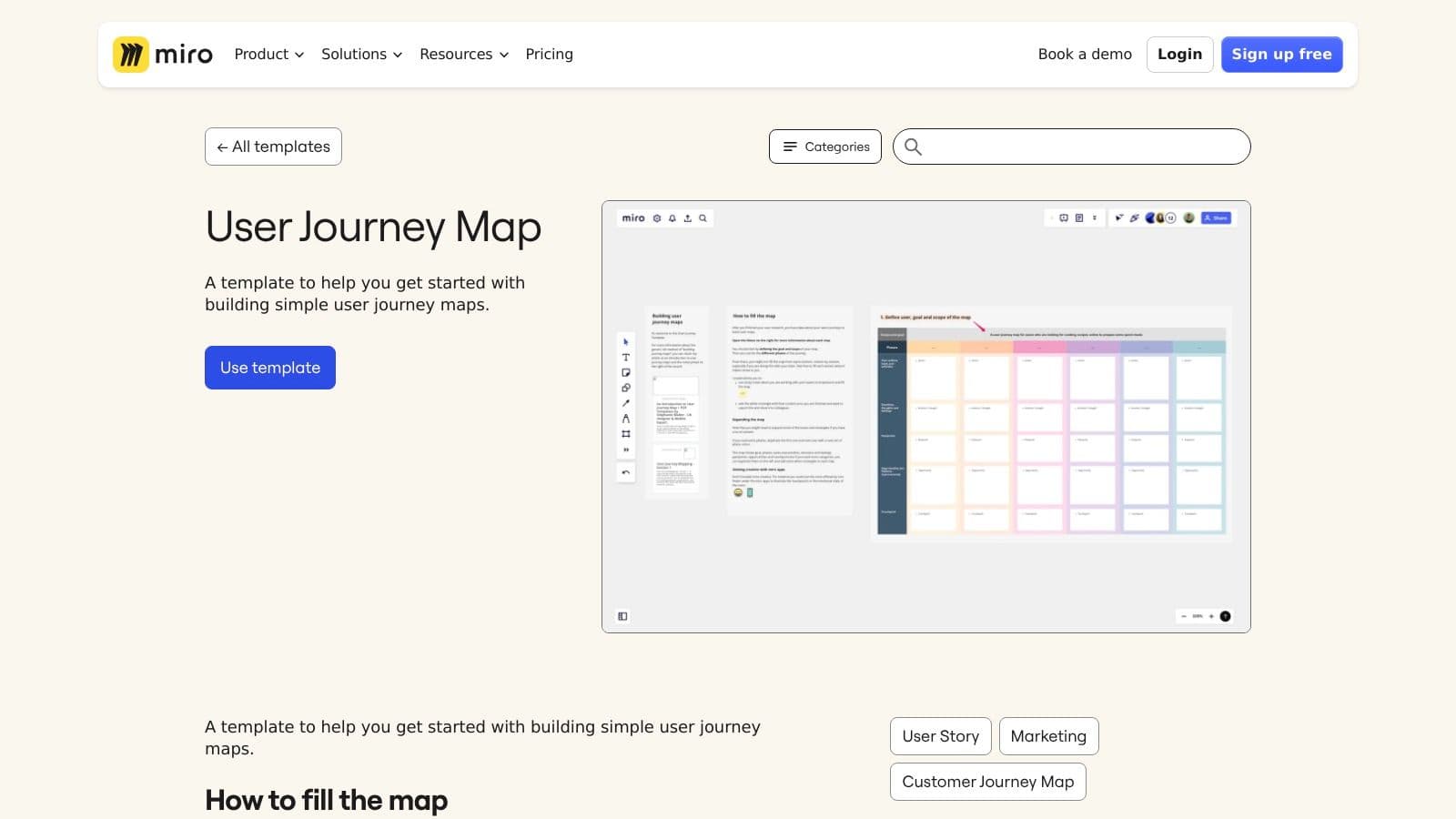
a67462ae-e0ca-4bd5-993e-d4aa87f49002.jpg
The templates are well-structured, typically including lanes for journey stages, user actions, touchpoints, thoughts, and emotions. Miro’s real strength lies in its facilitation tools, such as timers, voting, and private sticky notes, which help keep workshops organised and productive. This focus on live, interactive mapping sessions is what sets it apart from more static documentation tools.
Key Details & Analysis
| Feature | Details |
|---|---|
| Best Use Case | Live, collaborative workshops with distributed teams to build current-state or future-state journey maps. |
| Unique Offering | An extensive, community-driven template library (the Miroverse) beyond just standard user journey maps. |
| Access & Pricing | A free plan is available with limitations (e.g., 3 editable boards). Paid plans unlock unlimited boards and advanced features. |
| Implementation Tip | Before a workshop, pre-populate the template with known data and lock static elements to guide participants effectively. |
Pros:
- Huge ecosystem of high-quality templates.
- Excellent real-time collaboration and facilitation tools.
- Integrates with popular tools like Jira, Asana, and Slack.
Cons:
- Performance can slow down on extremely large, complex boards.
- The most valuable features are locked behind paid plans.
Website: https://miro.com/templates/user-journey-map/
2. Figma (FigJam)
FigJam, Figma’s online whiteboarding tool, has rapidly become a favourite for product and design teams, especially those already embedded in the Figma ecosystem. It excels at creating a seamless workflow from initial brainstorming to high-fidelity design. The platform offers a clean, intuitive canvas for building a user journey template collaboratively in real time.

8ff0a9ae-12ab-4846-88e1-064b8a203fb0.jpg
Its strength lies in its deep integration with Figma. Teams can copy and paste components directly from their design libraries into a journey map, ensuring visual consistency and speeding up the process. FigJam’s templates are clean and highly customisable, using specialised widgets like sticky notes and connectors that are optimised for diagramming. This makes it ideal for teams who want to iterate quickly on a journey map and keep it closely tied to the actual design files.
Key Details & Analysis
| Feature | Details |
|---|---|
| Best Use Case | Design teams mapping user journeys that need to stay tightly integrated with their Figma design files. |
| Unique Offering | The ability to directly pull live components from Figma design libraries into the journey map. |
| Access & Pricing | A free starter plan is available with up to 3 FigJam files. Paid plans offer unlimited files and advanced features. |
| Implementation Tip | Use FigJam's component feature to create a reusable kit of journey mapping elements for your team to ensure consistency across projects. |
Pros:
- Seamless experience and workflow for teams already using Figma.
- Clean, flexible templates that allow for easy iteration and customisation.
- Excellent real-time collaboration with intuitive commenting features.
Cons:
- Less extensive template library compared to dedicated whiteboard tools.
- Advanced features and exporting options are limited to paid plans.
Website: https://www.figma.com/templates/customer-journey-map/
3. Mural
Mural is a digital workspace designed for visual collaboration, positioning itself as a strong alternative for structured, facilitated workshops. It excels in guiding teams through complex processes, and its user journey template options are built with this principle in mind. The platform is particularly effective for cross-functional teams who may be less familiar with the journey mapping process.
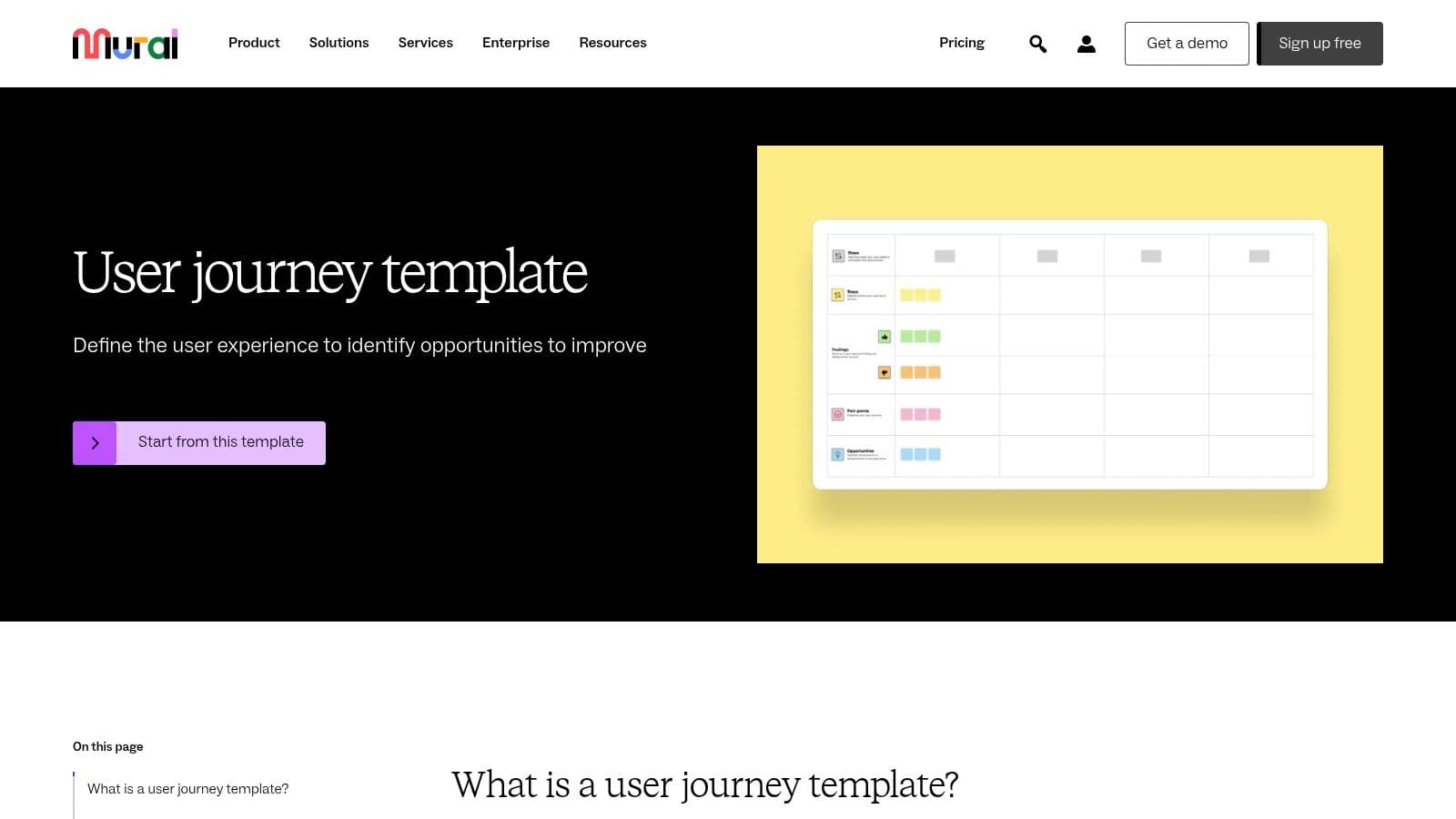
91723aa5-c5e6-4fa8-a5a9-cfc6469003e7.jpg
Unlike more open-ended canvases, many of Mural’s templates come with embedded step-by-step instructions and "how to run" tips, providing a clear framework from the start. This focus on structured facilitation is supported by powerful moderator controls, such as summoning all participants to one area of the board, timers, and private voting. This makes it an excellent choice for keeping large, diverse groups aligned and on-task.
Key Details & Analysis
| Feature | Details |
|---|---|
| Best Use Case | Facilitated workshops with cross-functional teams that require clear structure and step-by-step guidance. |
| Unique Offering | Embedded facilitation guidance and strong moderator controls designed to keep workshops focused and productive. |
| Access & Pricing | A free plan is available for individuals with some feature limits. Team and Business plans unlock premium templates and security features. |
| Implementation Tip | Use the "Facilitator Superpowers" like summon and timers to manage time and attention effectively during a live session. |
Pros:
- Excellent workshop UX and moderation features.
- Templates often include helpful prompts and guidance.
- Good for keeping large, cross-functional sessions organised.
Cons:
- The best and most comprehensive templates require a paid tier.
- There can be a slight learning curve for first-time facilitators.
Website: https://www.mural.co/templates/user-journey
4. Lucidchart
Lucidchart specialises in intelligent diagramming, offering a structured and data-driven approach to mapping customer experiences. It is particularly well-suited for teams that already use diagramming for flowcharts or process documentation and want to apply the same rigour to their user journey template. The platform excels at creating clean, professional-looking maps that are easy to share and present.
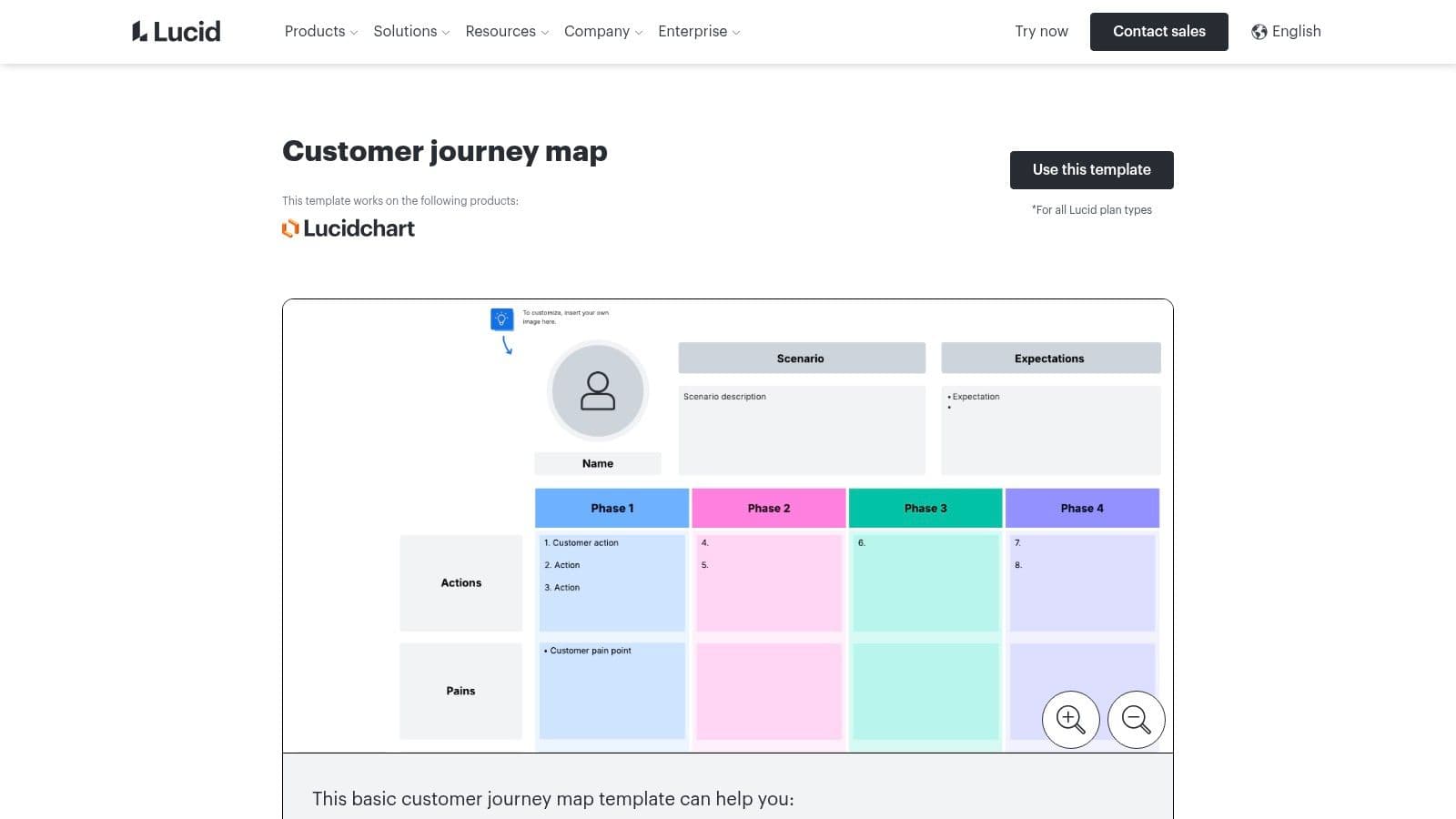
05874b07-684a-424e-a283-64caf5e3ecb8.jpg
Its strength lies in its precision and integration capabilities, especially within the Atlassian and Microsoft ecosystems. While it may not have the free-form, creative feel of a whiteboard tool, its templates provide a solid, customisable foundation. Features like data linking and presentation mode allow teams to create dynamic documents that can be easily embedded into wikis like Confluence or used in stakeholder presentations, ensuring the journey map remains a living, relevant artefact.
Key Details & Analysis
| Feature | Details |
|---|---|
| Best Use Case | Creating structured, professional diagrams for documentation and stakeholder presentations in corporate settings. |
| Unique Offering | Part of the Lucid Visual Collaboration Suite, integrating diagramming (Lucidchart) with whiteboarding (Lucidspark). |
| Access & Pricing | A free plan is available but limits users to 3 editable documents and 60 objects per document. Paid tiers unlock full features. |
| Implementation Tip | Use the data linking feature to connect map elements to live data sources, such as spreadsheets, to create dynamic maps. |
Pros:
- Excellent for teams that prefer structured, formal diagrams.
- Strong export options and integrations for easy stakeholder sharing.
- Integrates seamlessly with tools like Confluence, Jira, and Microsoft 365.
Cons:
- The free plan is quite restrictive on document and object counts.
- Less suited for free-form, brainstorming-style workshops.
Website: https://www.lucidchart.com/pages/templates/customer-journey-map
5. UXPressia
UXPressia is a specialised, purpose-built platform dedicated entirely to customer experience mapping. Unlike generalist whiteboard tools, its entire feature set is optimised for creating detailed journey maps, personas, and service blueprints. This focus makes it incredibly efficient for teams who need to produce professional, presentation-ready diagrams without the fuss of designing layouts from scratch. The platform provides a structured environment that guides users through creating a comprehensive user journey template.

1e844fbf-782d-4c7d-82a3-24c534d8982a.jpg
Its library contains over 100 templates organised by industry, which is a significant time-saver. A standout feature is the built-in AI assistant that can help generate initial personas or map structures, providing a solid starting point for teams. UXPressia excels at creating polished, shareable assets, making it a strong choice for documenting and communicating insights to stakeholders across an organisation. You can gain deeper insights into the different customer journey stages to enhance your maps.
Key Details & Analysis
| Feature | Details |
|---|---|
| Best Use Case | Creating polished, professional journey maps, service blueprints, and personas for stakeholder reporting. |
| Unique Offering | A suite of specialised tools focused solely on CX mapping, including an AI helper for map generation. |
| Access & Pricing | A free plan allows for one project. Paid plans are required for features like PPTX/CSV exports and team libraries. |
| Implementation Tip | Use the persona builder first to ground your journey map in user-centric data before you begin mapping. |
Pros:
- Purpose-built for customer journey and UX mapping.
- Strong export options (PDF, PPTX, PNG, CSV) accelerate stakeholder reporting.
- Excellent selection of industry-specific templates.
Cons:
- Best features are only available on Pro and Business plans.
- The user interface is less flexible for generic whiteboarding tasks.
Website: https://uxpressia.com/templates
6. Smaply
Smaply is a dedicated service design platform that brings a high degree of structure and standardisation to customer experience management. It's built specifically for creating, managing, and sharing detailed journey maps, personas, and stakeholder maps. Unlike more free-form visual tools, Smaply provides a structured, repeatable process for building out a comprehensive user journey template.
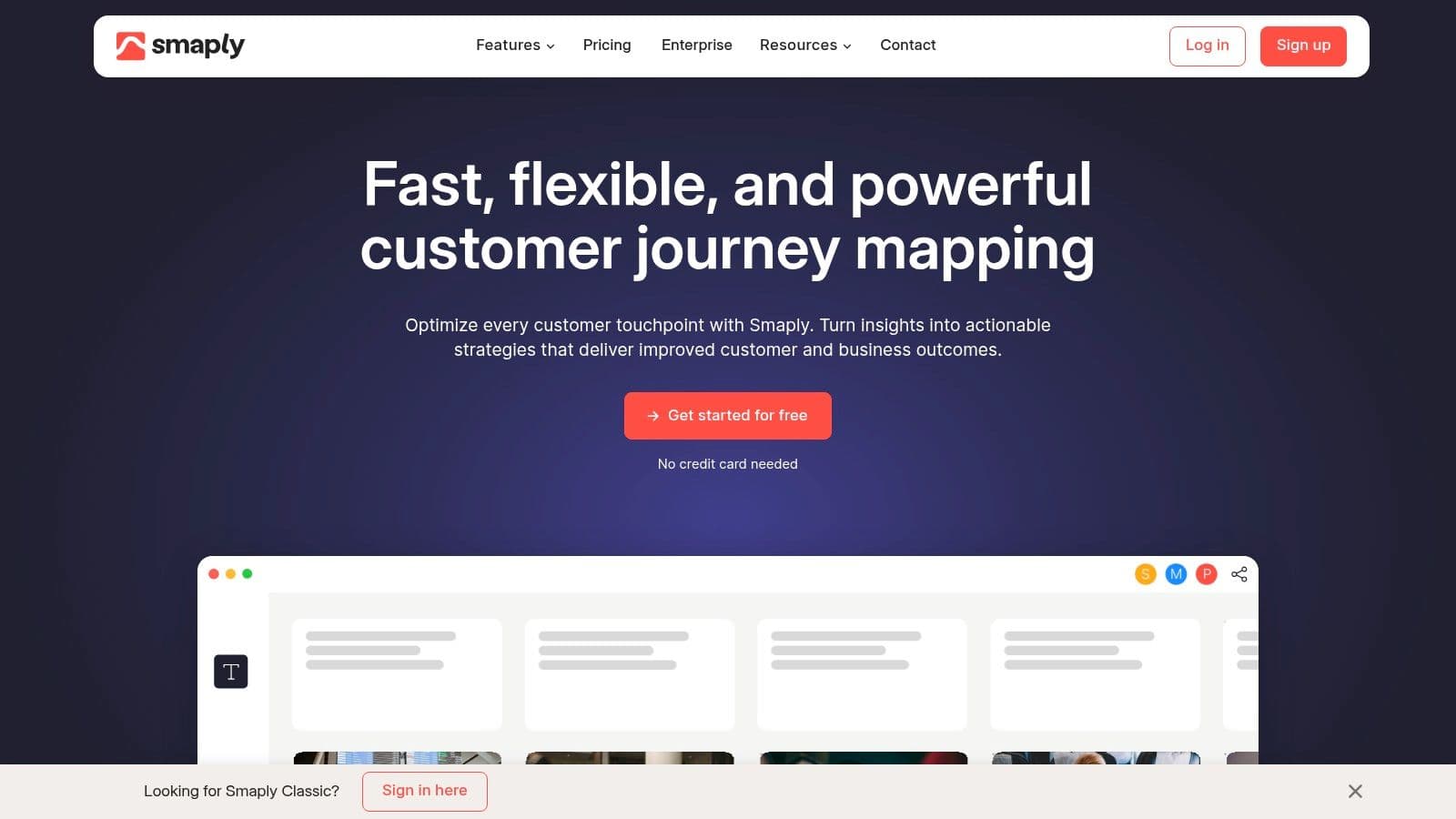
5e4f66a9-8158-47e9-a11e-5b5c5fcf6a2e.jpg
The platform excels in organisations that need to manage a large portfolio of journey maps and ensure consistency across teams. Its strength lies in its governance-friendly features, such as hierarchical mapping that connects different journey levels, and robust sharing options. This focus on creating a centralised, well-organised repository of customer insights is what differentiates Smaply from general-purpose whiteboard tools, making it ideal for enterprise-level service design initiatives.
Key Details & Analysis
| Feature | Details |
|---|---|
| Best Use Case | Enterprise teams standardising their journey mapping practice and building a central repository of insights. |
| Unique Offering | Optional single-tenant hosting for data governance and a structured, form-based interface for consistency. |
| Access & Pricing | A limited free plan is offered. Paid plans unlock more maps, viewer seats, and advanced integrations. |
| Implementation Tip | Use the persona and stakeholder map features first to build a solid foundation before diving into journey maps. |
Pros:
- Excellent governance features for standardising journey mapping.
- Strong portfolio and saved views management for large-scale use.
- Integrates with tools like Jira, Power BI, and Google Analytics.
Cons:
- The interface is more form-based and less visually free-form.
- Viewer seats and key features are locked behind higher-tier plans.
Website: https://www.smaply.com/
7. Creately
Creately is a versatile visual collaboration and diagramming platform that excels in both structured templates and free-form brainstorming. It provides a strong library of editable templates, covering customer, user, and even niche experience maps like patient journeys. This makes it a great starting point for teams who need a solid foundation for their user journey template but also want the flexibility to adapt it extensively.
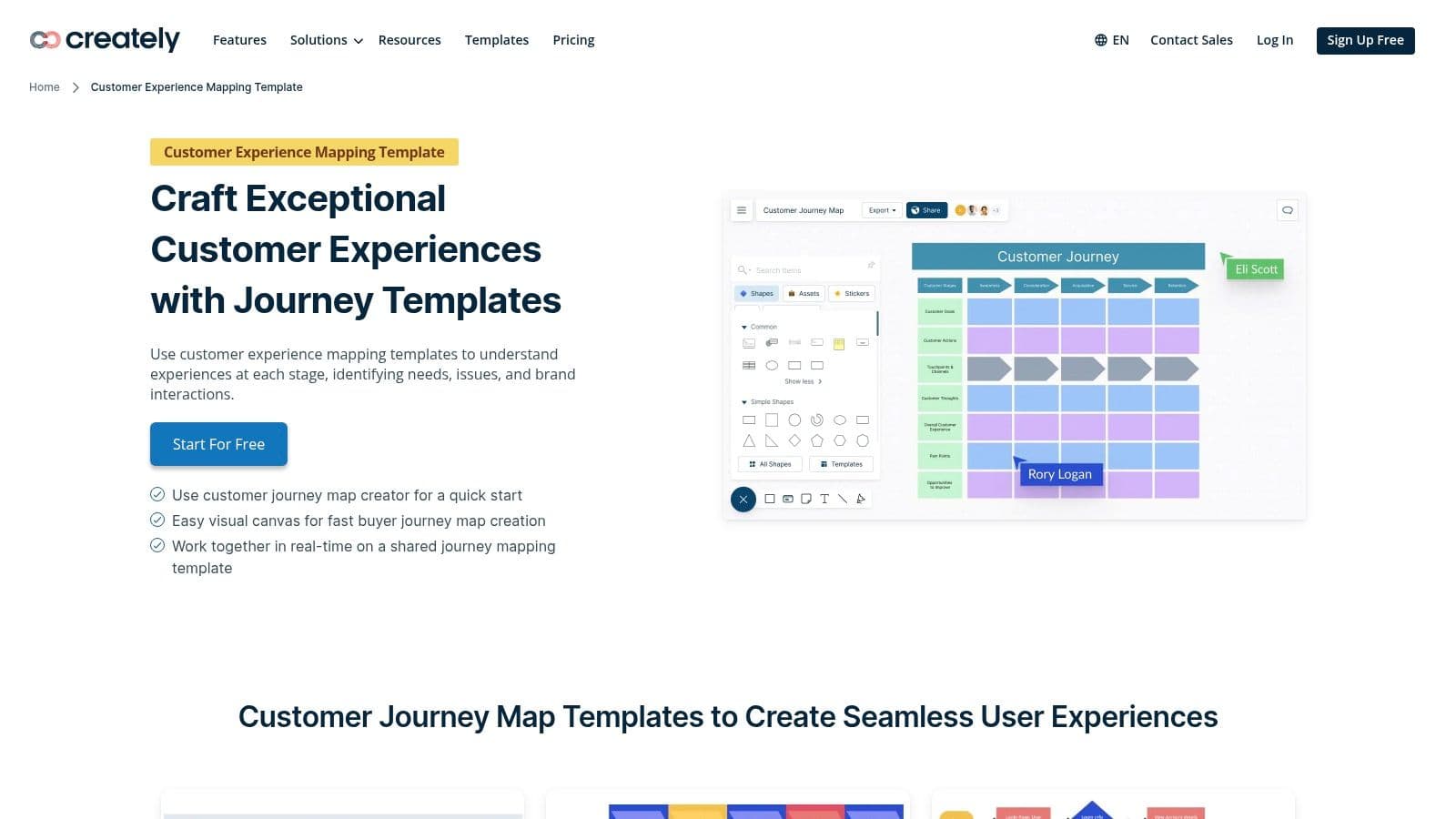
60025f13-c83a-4dfb-b181-889459bd83cf.jpg
The platform focuses on making visual work accessible and shareable. It offers real-time collaboration with in-context comments and versioning, helping teams track changes and provide feedback directly on the map. Creately's strength is its blend of a simple user interface with powerful diagramming capabilities, allowing users to quickly create, export, and embed professional-looking journey maps without a steep learning curve.
Key Details & Analysis
| Feature | Details |
|---|---|
| Best Use Case | Teams needing a straightforward tool for creating, sharing, and embedding journey maps in documentation. |
| Unique Offering | A hybrid approach combining a rich template gallery with flexible, general-purpose diagramming tools. |
| Access & Pricing | A free plan is offered with limited objects and folders. Paid plans are required for advanced features like unlimited canvases. |
| Implementation Tip | Use the persona templates alongside the journey map to keep the user's goals and pain points front-and-centre during mapping. |
Pros:
- Flexible diagramming combined with a good template library.
- Simple export options (PNG, SVG, PDF) and easy sharing via links.
- Includes a variety of map types, including specific patient journeys.
Cons:
- Community-submitted templates can have inconsistent quality.
- Advanced collaboration features and unlimited use require a paid subscription.
Website: https://creately.com/usage/customer-journey-mapping-tools-templates/
8. Venngage
Venngage is an online infographic maker that excels at producing visually polished, presentation-ready documents. While not a dedicated UX tool, its strength lies in helping non-designers quickly create professional-looking journey maps that are perfect for sharing with stakeholders or including in reports. The platform offers a variety of well-designed templates for a user journey template that can be customised with ease.
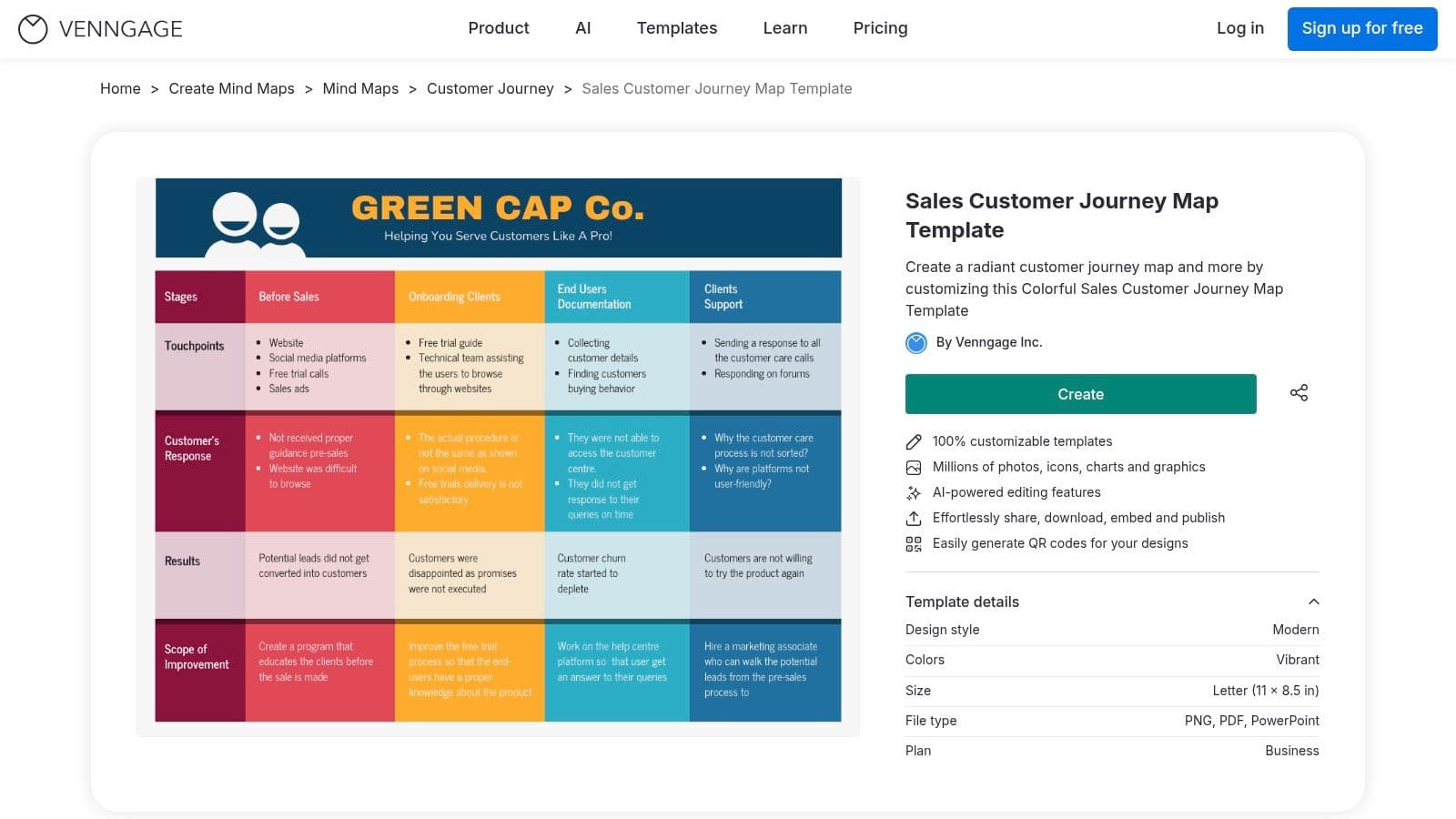
4e005f95-8643-4646-ac56-6453800fb5ef.jpg
The focus is less on live, collaborative mapping and more on the final artefact. Venngage provides extensive libraries of icons, photos, and branding options to ensure the final map aligns with your company's visual identity. This makes it an ideal tool for transforming raw workshop outputs from other platforms into a final, digestible format for executive-level presentations.
Key Details & Analysis
| Feature | Details |
|---|---|
| Best Use Case | Creating static, visually appealing customer journey maps for presentations, reports, and stakeholder communication. |
| Unique Offering | Infographic-style templates that simplify the creation of polished visuals without requiring design expertise. |
| Access & Pricing | A free plan is available with significant limitations on exports and features. Paid plans unlock high-res exports (PNG, PDF) and branding kits. |
| Implementation Tip | Use Venngage as the final step in your process. Map out your journey in a collaborative tool first, then recreate it in Venngage for a polished look. |
Pros:
- Excellent for creating high-quality, executive-ready visuals quickly.
- Very low learning curve, making it accessible for non-designers.
- Good selection of icons and brand customisation features.
Cons:
- Not suitable for real-time, collaborative workshop facilitation.
- The free plan is very restrictive, especially regarding export options.
9. Visme
Visme positions itself as a visual communication tool, making it ideal for creating journey maps that need to be presented and shared as polished documents. It excels at turning a standard user journey template into a presentation-ready infographic or interactive whiteboard, focusing on visual storytelling rather than just raw data mapping. The platform combines template-based design with a rich library of visual assets.
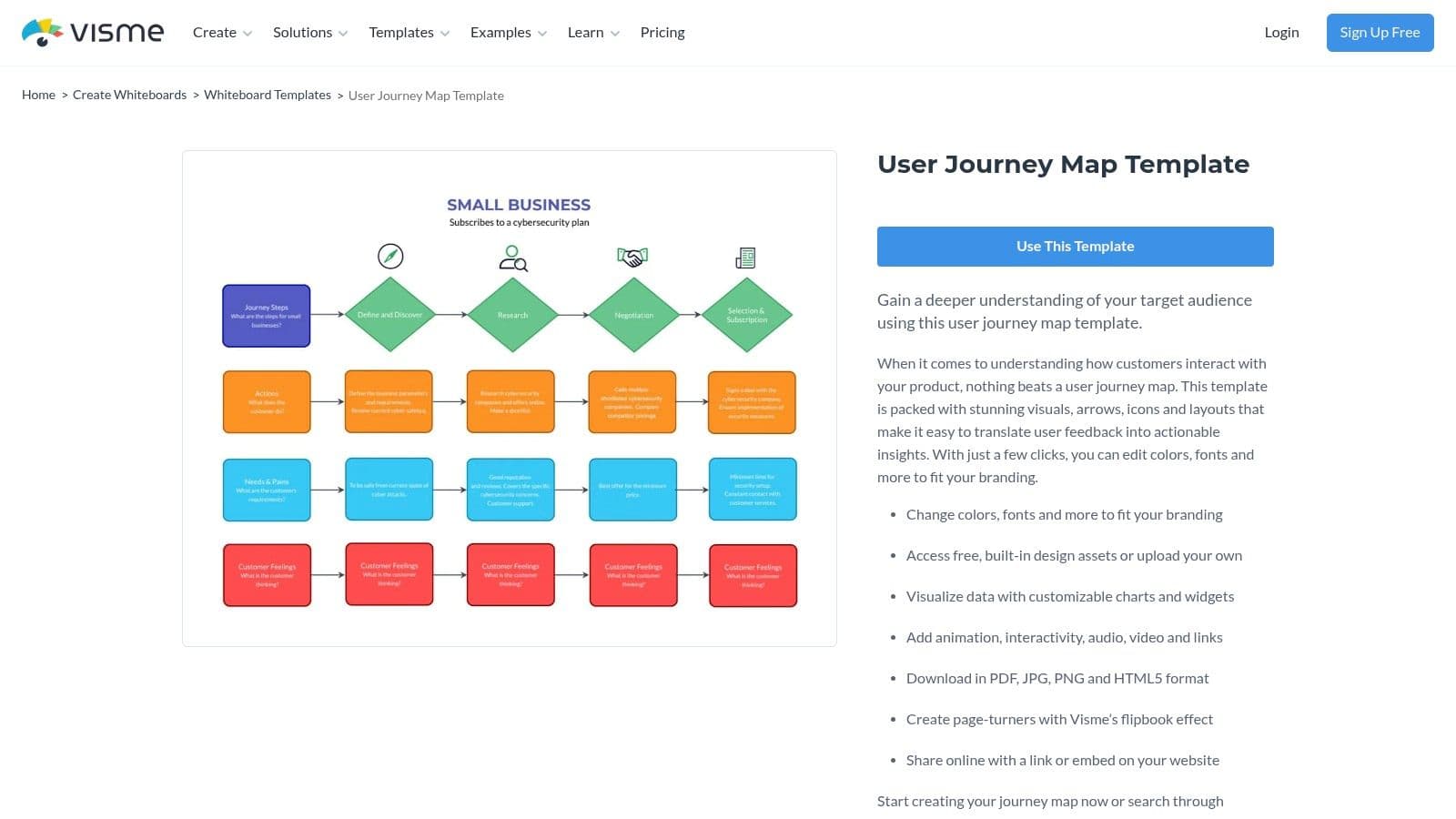
9d7b9b58-1a1c-43e7-a983-9d700cf6018e.jpg
Its strength lies in transforming data into a compelling narrative using charts, customisable icons, and brand-aligned visuals. Unlike pure whiteboarding tools, Visme's templates are designed with aesthetics in mind, allowing teams to create high-fidelity maps for stakeholder presentations or reports. The ability to export in multiple formats, including interactive HTML5, provides flexibility for sharing the final output.
Key Details & Analysis
| Feature | Details |
|---|---|
| Best Use Case | Creating visually appealing, presentation-quality journey maps for stakeholder reports and formal documentation. |
| Unique Offering | Interactive elements like pop-ups and links within the map, and robust export options including HTML5. |
| Access & Pricing | A free plan is offered with limited templates and Visme branding. Paid plans unlock premium assets and export formats. |
| Implementation Tip | Use the brand kit feature to pre-load your company's colours, fonts, and logos for a consistent, professional look. |
Pros:
- Highly customisable visuals ideal for compelling presentations.
- Robust asset libraries and branding tools to ensure consistency.
- Multiple export options, including interactive formats.
Cons:
- Collaboration tools are lighter compared to dedicated whiteboards.
- Advanced export features and premium templates require a paid plan.
Website: https://www.visme.co/templates/whiteboards/user-journey-map-templates-1425288969/
10. Canvanizer
Canvanizer is a lightweight, browser-based canvas tool that prioritises speed and simplicity over extensive features. It is designed for teams that need to start mapping immediately without the friction of account creation or software installation. The platform provides a pre-formatted, structured user journey template that is ideal for quick ideation sessions or workshops where getting started quickly is the main priority.

d0b6512d-3e53-4182-bab1-bbd7a64e48f4.jpg
Unlike more complex digital whiteboards, Canvanizer’s strength is its focused, no-frills approach. It provides a simple framework with editable segments, allowing teams to capture key insights without being overwhelmed by customisation options. Its shareable links and export functions (PDF/image) make it a practical choice for capturing early-stage thinking and sharing it with stakeholders before moving the map into a more high-fidelity tool for refinement.
Key Details & Analysis
| Feature | Details |
|---|---|
| Best Use Case | Rapid, low-fidelity journey mapping for early-stage ideation, small teams, or budget-constrained workshops. |
| Unique Offering | An entirely browser-based experience with zero setup or onboarding required to start a mapping session. |
| Access & Pricing | Free to use. The platform generates a unique, shareable URL for each canvas, with no sign-up needed. |
| Implementation Tip | Use it to quickly digitise ideas from a physical whiteboard session before they are lost or need formalising. |
Pros:
- Extremely fast to start, requires no installation or sign-up.
- The focused template prevents distraction and encourages core mapping.
- Works well for small teams or individuals needing a quick draft.
Cons:
- Lacks the advanced collaboration and design features of larger platforms.
- The interface is less polished and robust compared to competitors.
Website: https://canvanizer.com/canvas/customer-journey-demo
11. Atlassian Confluence
For teams deeply embedded in the Atlassian ecosystem, Confluence offers a native and highly practical solution for documentation-centric journey mapping. It provides a structured, built-in user journey template that lives alongside project requirements, research findings, and technical specifications. This integration ensures that the journey map is not an isolated artefact but a core part of the project's living documentation, accessible to developers, product managers, and other stakeholders.
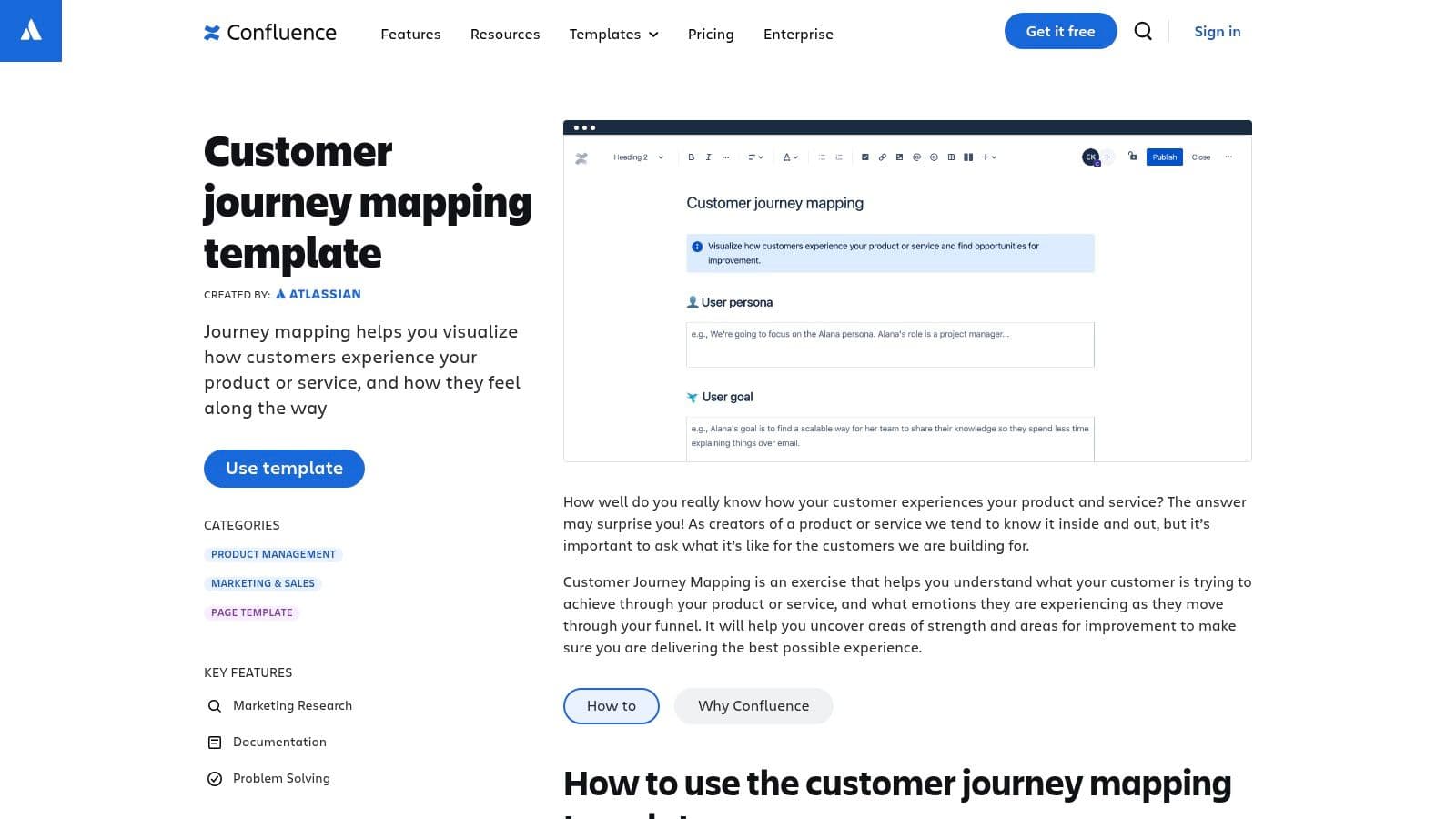
b8a1affd-fa6b-4f2c-8435-8f77d29087a2.jpg
The template is organised with clear sections for stages, user actions, pain points, emotions, and opportunities, making it easy to standardise across projects. Confluence excels at connecting various knowledge pieces, allowing teams to link journey maps directly to customer interview notes or competitive analysis pages. The platform's strengths in permissions, version history, and comments make it ideal for asynchronous collaboration and maintaining an official source of truth.
Key Details & Analysis
| Feature | Details |
|---|---|
| Best Use Case | Documenting and sharing finalised journey maps within organisations that use Jira and Confluence for project management. |
| Unique Offering | Seamless integration with the Atlassian suite, turning the journey map into a central, linkable knowledge base asset. |
| Access & Pricing | A free plan is available for up to 10 users. Paid plans offer more users, storage, and advanced permissions. |
| Implementation Tip | Use the template as the "source of truth" and link directly to it from related Jira epics and stories to provide context for developers. |
Pros:
- Excellent for teams already using the Atlassian stack (Jira).
- Easy access and contribution for non-design stakeholders.
- Strong version control and documentation features.
Cons:
- Less visual and interactive than dedicated whiteboard tools.
- The experience for real-time, collaborative mapping is limited.
Website: https://www.atlassian.com/software/confluence/templates/customer-journey-mapping
12. HubSpot
HubSpot, a leader in marketing and sales software, offers a free downloadable set of customer journey map templates that are perfect for teams needing a solid, printable starting point. Instead of a complex SaaS tool, HubSpot provides a resource pack that covers multiple common use cases, from the initial buyer's journey to mapping customer churn. This makes it an accessible option for aligning marketing, sales, and service teams on the fundamentals of the customer experience.
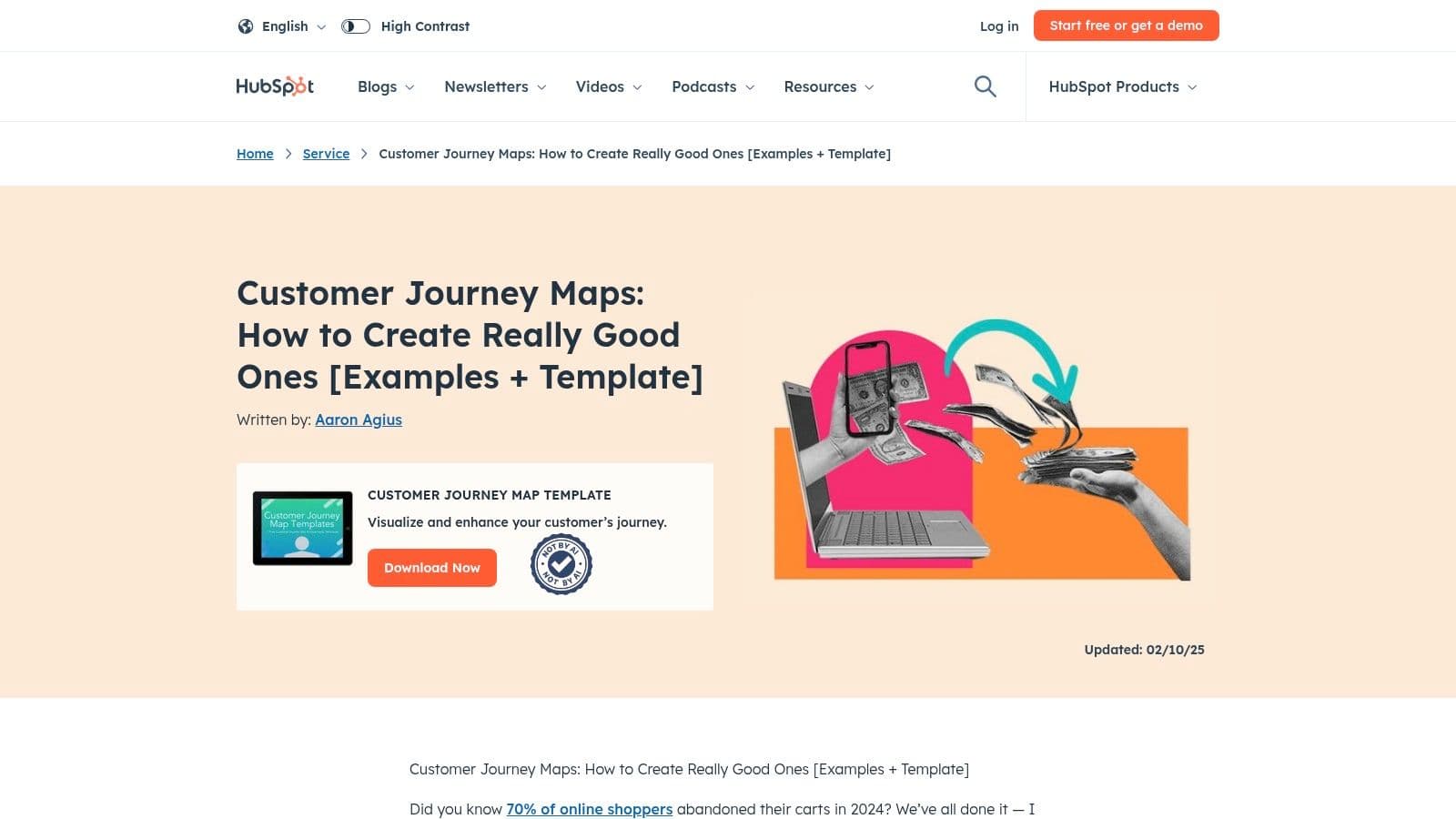
c4c682b3-bc3b-4349-877d-fd15e17b7546.jpg
The templates are available in multiple formats, including PowerPoint, and can be imported into digital whiteboards like Miro or Figma for collaborative work. What makes this resource particularly valuable is the extensive guidance and examples provided in companion articles, turning the templates from simple documents into educational tools. This focus on practical application helps teams understand not just the what but the why behind their user journey template.
Key Details & Analysis
| Feature | Details |
|---|---|
| Best Use Case | Teams looking for a free, versatile, and educational starting point for creating various types of journey maps without committing to a new platform. |
| Unique Offering | A free, multi-format template pack including buyer’s journey, current vs. future state, and day-in-the-life maps. |
| Access & Pricing | Completely free to download after providing contact information. |
| Implementation Tip | Use the provided examples in the companion blog post to guide your team's first mapping session and establish a shared understanding of the process. |
Pros:
- Completely free and provides broad coverage of different journey formats.
- Useful for aligning marketing, customer service, and product teams.
- Excellent companion content and guidance for beginners.
Cons:
- Inherently static and less interactive than dedicated SaaS platforms.
- The download process requires submitting contact details.
Website: https://blog.hubspot.com/service/customer-journey-map/
User Journey Template Tools Comparison
| Platform | Core Features & Integration | User Experience & Collaboration | Unique Selling Points ✨ | Target Audience 👥 | Price & Value 💰 |
|---|---|---|---|---|---|
| Miro | Real-time whiteboard, extensive journey templates | Strong facilitation, multi-user sync | Huge template ecosystem 🏆 | Product & UX teams, workshops 👥 | Paid plans best value 💰 |
| Figma (FigJam) | Figma component integration, drag-drop widgets | Smooth for Figma users, real-time collab | Seamless Figma ecosystem use ✨ | Design teams & Figma users 👥 | Paid for exports/features 💰 |
| Mural | Guided templates, facilitator controls | Workshop-focused with voting & timer | Embedded workshop tips ✨ | Cross-functional teams 👥 | Paid plan needed for more 💰 |
| Lucidchart | Diagram-driven maps, Confluence/Jira integration | Structured diagrams, easy exports | Part of Lucid Suite | Structured diagram users 👥 | Free limits; paid for features |
| UXPressia | 100+ templates, AI-assisted map & persona gen | Real-time collab, reusable components | AI helpers & journey focus ✨ | UX, CX professionals 👥 | Pro/Business tiers required 💰 |
| Smaply | Hierarchical templates, data governance options | Governance & portfolio management | Regional hosting, password sharing ✨ | Service design teams, governance 👥 | Higher tiers for features 💰 |
| Creately | Visual collab, editable templates | Real-time collab, comments, versioning | Flexible diagrams + template library | Visual collaborators 👥 | Paid subscription needed 💰 |
| Venngage | Infographic-style templates | Easy editing for non-designers | Executive-ready visuals quickly ✨ | Non-designers & marketers 👥 | Export limits free; paid 💰 |
| Visme | Interactive infographics & whiteboards | Custom visuals, presentation focus | Interactive elements & branding tools | Presenters & marketers 👥 | Paid plans for exports 💰 |
| Canvanizer | Browser-based, pre-formatted canvases | Minimal setup, history, PDF export | Quick drafts, lightweight tool | Small teams, budget workshops 👥 | Free with limited polish |
| Atlassian Confluence | Integrated with Jira, structured templates | Documentation-centric, limited realtime | Fits Atlassian stack seamlessly | Atlassian ecosystem users 👥 | Included with Atlassian |
| HubSpot | Free downloadable templates & guides | Static templates, printable | Completely free, multi-format pack 💰 | Marketing, customer service 👥 | Free |
Start Mapping Your Way to a Better Customer Experience
We've explored a comprehensive suite of tools, from dedicated journey mapping platforms like UXPressia and Smaply to versatile visual collaboration hubs such as Miro and FigJam. Each offers a unique pathway to understanding your audience, but the destination is always the same: a more intuitive, satisfying, and valuable user experience. Moving beyond abstract ideas and into visual representation is the first, most crucial step in fostering true customer-centricity within your organisation.
The power of a user journey template isn't just in the final artefact; it’s in the process of creating it. It forces you and your team to walk in your customers' shoes, ask difficult questions, and confront assumptions with real data and empathy. This process uncovers the hidden friction points, the moments of delight, and the critical opportunities for improvement that often go unnoticed in day-to-day operations.
Choosing Your Starting Point
Selecting the right tool depends entirely on your team's context, technical maturity, and specific goals.
- For collaborative, cross-functional teams: Tools like Miro, Mural, and FigJam excel. Their infinite canvases and real-time features make them ideal for brainstorming workshops and ensuring everyone from marketing to development has a voice.
- For data-driven, in-depth analysis: Consider dedicated platforms like UXPressia or Smaply. These offer structured templates with personas, empathy maps, and data integration capabilities, perfect for product managers and UX researchers who need granular detail.
- For quick visualisation and presentations: Tools like Venngage, Visme, or even HubSpot’s built-in features provide polished, easy-to-create maps that are perfect for sharing insights with stakeholders or integrating into reports.
Remember, the goal is not to find a single, perfect tool for all time, but to choose the one that removes the most friction right now. Start simple. A basic template in Creately or Canvanizer can be just as effective at sparking initial conversations as a complex, data-heavy map in a specialised tool.
From Map to Meaningful Action
A user journey map is only as valuable as the actions it inspires. Once your map is created, it should become a living document, a strategic guidepost for your business. Use it to prioritise feature development, refine your content strategy, and train your customer support team. For broader perspectives on enhancing your overall customer experience, consider resources from other experts in the field who share valuable customer experience insights that can complement your mapping efforts.
Ultimately, your user journey template is your blueprint for building better relationships. It’s a commitment to seeing your business through your customers' eyes. By embracing this perspective, you're not just optimising a process; you're building a foundation for sustainable growth and lasting customer loyalty.
Ready to turn your journey map insights into a seamless member experience? MyMembers helps you manage, engage, and grow your community on Telegram with powerful automation and analytics. Simplify your subscription management and focus on delivering value at every stage of the user journey. Discover how MyMembers can transform your community today.
